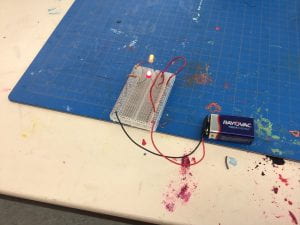In this post I will be talking process behind building my first simple circuit, Below is a picture of the product:
First we collected our materials, and that consisted of the breadboard, the led lights, the wires, the battery, the clip that attaches to the battery (with wires attached to the clip), and the resistors. The first step to making the circuit was to attach the clip to the battery. Then you had to attach the red wire to a positive column and attach the black wire to a negative column on the opposite side of the breadboard. Next, you used your wire cutter to slice the outer plastic of of a red wire (4 inches long on each side of the wire). Those ends without the plastic layer will be used to stick in the breadboard. Next, you place your led light in the breadboard by placing the shorter leg on the side with the negative column on the right side. Then you place the longer leg in the same row as the shorter leg but on the side of the board. Next, you take the wire (that you sliced the outer plastic off) and you stick one end of the wire in the positive column and the other in the same row as your led light. Finally, you take one resistor and attaching side of it to the negative column, and attach the another side to the same row as your led light. Finally, your led light will light up. You can repeat that process to make a second led light light up.
Soon, we will be making more advanced circuits and I can’t wait to learn more!


